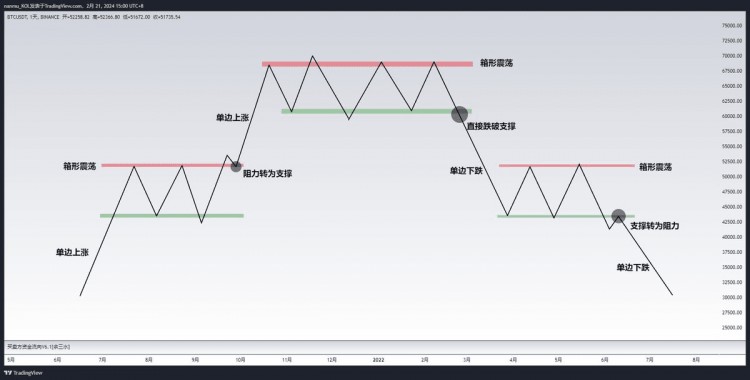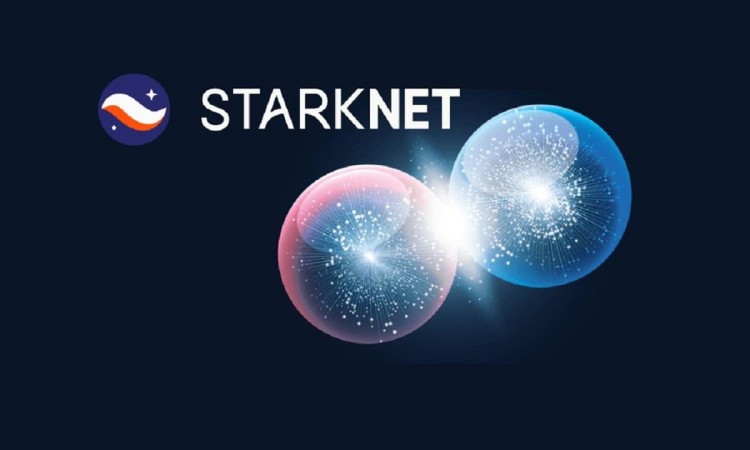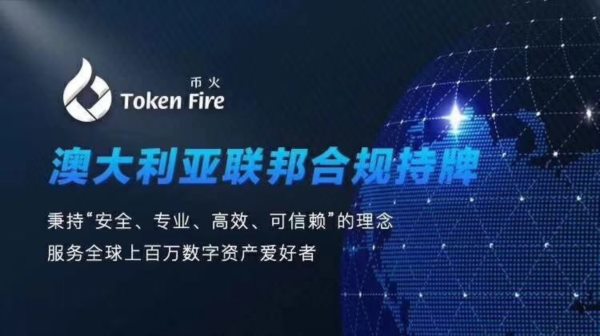时间:2024-01-31|浏览:270

用戶喜愛的交易所

已有账号登陆后会弹出下载
From Fellowship to Stack to RaaS, the competition between L2 has entered the gaming field this time.
Yesterday, Optimism co-founder and chief scientist Ben Jones proposed that Treasure join Optimism Superchain and build Treasure Chain based on OP Stack. Immediately afterwards, Omar, head of BD of zkSync developer Matter Labs, published a proposal in the TreasureDAO community today, hoping that Treasure Chain will use ZK Stack as Layer 2.
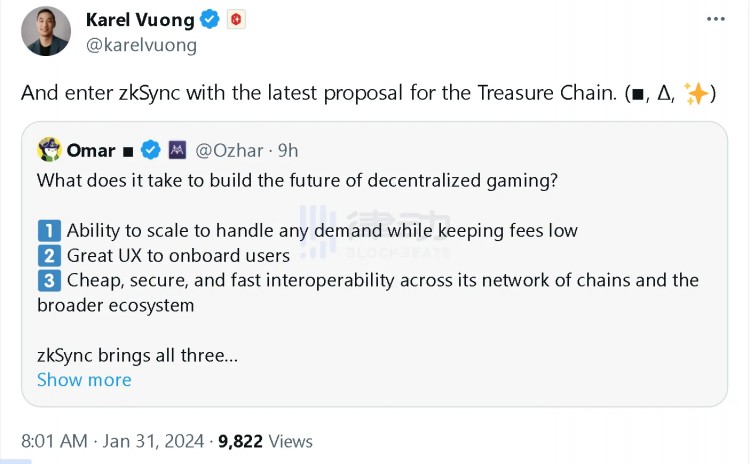
It is reported that in the Treasure ecosystem, the most interesting game is a game called Lighthouse. It is currently a diamond partner of TreasureDAO. In the future, there is a high probability that the Lighthouse game can be funded by TreasureDAO’s harvester of 6 million MAGIC Tokens. This harvester grant is used to pay players for their gold gains.
Related reading: "Observing TreasureDAO using the Lighthouse game as an entry point"
As early as November 25 last year, TreasureDAO co-founder Karel Vuong had made it clear that TreasureDAO was building a game chain and planned to use MAGIC as a Gas token, possibly based on the Arbitrum chain or the Cosmos chain. Subsequently, TreasureDAO team member Sambino revealed in the Discord community that Treasure Chain Litepaper will be released in a week. However, after Optimism stepped in to grab Treasure Chain, Karel Vuong announced that the release of Treasure Chain Litepaper was postponed to February 5th.
Interestingly, in this battle for Treasure, it was Arbitrum who initially intervened.
Long before Optimism proposed it, Treasure was listed as a member of its L3 circuit. In addition, in the early days, TreasureDAO and Arbitrum both promoted the Lighthouse game many times and held many AMA activities. As a relatively large community, TreasureDAO has a certain mass base. TreasureDAO occupies the leading position of games in the Arbitrum ecosystem and has a certain say in the entire Arbitrum ecosystem.
L2 competition has entered a white-hot stage during last year’s bear market
Not just Treasure, due to the many star projects, the fierce competition on the L2 track has become a well-known fact in the entire encryption industry.
In addition to OP Stack and ZK Stack launched by Optimism and zkSync, competition between the OP Rollup camp and the ZK Rollup camp in the RaaS field includes Orbit launched by Arbitrum and Appchain launched by Starknet. In the field of zkEVM, the tense relationship between the two "domestic light" projects Scroll and Taiko has also become an open secret in the industry.
"Stack Battle"
In the L2 competition, when you think of zkSync, you think of Optimism. In June last year, zkSync quickly launched ZK Stack after OP Stack, which also aroused heated discussions in the community.
OP Stack, which has the first-mover advantage, not only cooperated with coinbase to create the super chain structure and the second-layer solution Base, but also won the favor of BNB Chain, a "leading public chain", and launched a new expansion solution opBNB for BNB Chain.
In addition, many application development teams also choose to develop their own application chains based on OP Stack. For example, the game digital economy platform Cocos-BCX cooperated with NodeReal to jointly develop the first Web3 game-centered Rollup Layer2 on BNB Chain based on OP Stack; a16z Crypto launched the Optimism Stack rollup client Mag; on June 22, the NFT trading market Zora Launched the Layer 2 network ZORA NETWORK based on OP Stack.
Compared to OP Stack, which has a first-mover advantage and has attracted multiple development teams, ZK Stack has more technical advantages, but just like its performance in this expansion war, zkSync always seems to lack a little innovation.
In early August last year, Polygon Zero, the official zero-knowledge proof team of Polygon, publicly criticized zkSync in an article titled "Protecting the Spirit of Open Source," claiming that it copied Polygon's open source code without permission and published misleading remarks. Suddenly it attracted widespread attention in the industry.
Later, zkSync imitated Consensys and launched the Fellowship program. Different from the previous remarkable technical advantages, this imitation is relatively "rough". Compared with the well-prepared Consensys, the entire plan only has a list of topics and an article introduction.
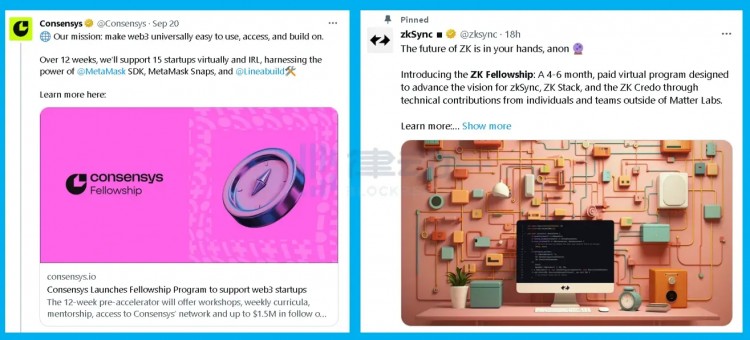
Four companies compete for ApeChain
In March 2022, ApeCoin, the native token of the BAYC NFT ecosystem, was launched. At the same time, the decentralized autonomous organization ApeCoin DAO, which was specifically used to operate token-related matters, was also created. Subsequently, the development and maintenance rights of its L2 network ApeChain were acquired by many L2 Scramble.
Polygon was the first L2 to propose the development and maintenance of ApeChain. On October 11 last year, Polygon Labs co-founder Sandeep Nailwal proposed that ApeCoin DAO use the Polygon Chain Development Kit (CDK) to develop and maintain its L2 network ApeChain. A month later, Optimism stepped in, with its co-founder and chief scientist Ben Jones proposing that ApeCoin DAO develop and maintain its L2 network ApeChain on Optimism Superchain.
Immediately afterwards, Nina Rong, director of ecosystem development at the Arbitrum Foundation, also proposed, "ApeChain is developed using Arbitrum technology, and its growth will be led by Horizen Labs." This proposal was also labeled "High Importance" by Messari. Horizen Labs, mentioned in the proposal, has helped the ApeCoin DAO community launch several major initiatives, including ApeCoin, Otherside, and ApeStake within the Ape ecosystem.
After seeing the efforts of Polygon, Optimism, and Arbitrum, zkSync joined the fray. On December 16, zkSync proposed in the ApeCoin DAO community to “build ApeChain using the fastest and cheapest ZK technology in production.”
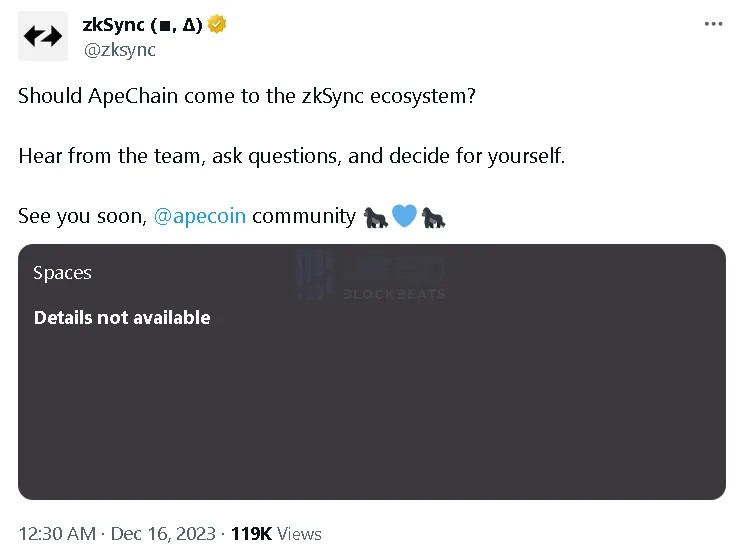
Finally, WebSlinger, the administrator of the ApeCoin DAO, announced the creation of a Request for Proposal (RFP) process, and everyone who wants to build ApeChain for the DAO can participate. When the community feedback period ends on January 31, one or two rounds of voting will be held to decide who will build ApeChain for ApeCoin DAO, depending on the number of ApeChain AIP submitted. The first vote is scheduled to take place from February 1 to February 7, according to the RFP.
New and old L2 each show their talents, RaaS enters halfway
Airdrop was originally a strategy used by Uniswap to deal with the vampire attack of SushiSwap. In the end, it became the biggest shortcut for ordinary people in the encryption field to obtain wealth effects, and this also provided a new way of thinking for L2 competition in disguise.
Blast turns on the "head rolling" mode
Previously, Blur founder Pacman’s new L2 project Blast earned a lot of attention through social fission and airdrop expectations.
Before Blast, L2 projects focused more on technology involution, but this phenomenon was defeated by Blast. Mission PUA, airdrop bait, to Vitalik style inward roll, etc., Blast's blend completely spreads Layer 2's shameless bottom.
Blast claims that the existing base interest rate for Layer 2 is 0%. By default, the value of users’ assets will depreciate over time, while on Blast, users’ balances will automatically compound interest and earn additional Blast rewards. When a user deposits funds into Blast, Blast will then use the corresponding ETH locked on the Layer 1 network for native pledge of the network, and automatically return the obtained ETH pledge income to the users on Blast. In addition, Blast also supports passive interest generation of stablecoins.
For users, in addition to the passive income earned from staking, Blast also introduces a points system similar to the gameplay of Blur.
On January 17, when Blast users exceeded 100,000 and TVL exceeded US$1.3 billion, Blast announced that its test network has been officially launched, and at the same time launched the "Blast BIG BANG" activity for developers to attract Dapps to settle in. Blast said the winning DApps will be promoted to Blast users after the mainnet launches at the end of February. With this, the winning team can use the Blast airdrop to incentivize the development of their DApp on the Blast mainnet and gain core advantages such as liquidity guidance from the beginning.
Of the Blast airdrop, 50% will be distributed to 110,000 users, and 50% will be distributed to Blast developers (including BIG BANG winners and mainnet DApps). According to Blast documentation, a portion of the Blast developer airdrop is reserved for competition winners and a portion is reserved for mainnet DApps. The exact allocation ratio has not been announced, but the vast majority of airdrops will be reserved for mainnet DApps (i.e., more than 90%). However, Blast also emphasized that users will not receive anything for participating in the testnet.
As can be seen from the Blast BIG BANG competition theme c




